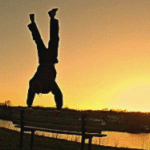How Fast Can You Realistically Learn a Handstand with Private Coaching?
- The Realistic Timeline with Private Coaching
With consistent private coaching, most individuals starting with foundational strength and mobility can expect to achieve a solid, consistent freestanding handstand hold of 5-10 seconds within 3 to 6 months. Some might progress faster, achieving holds in 2-3 months, while others might take 6-12 months or even longer, particularly if they have significant mobility limitations or fear.
It’s crucial to understand that “learning a handstand” is often a progression:
Initial Stages (Weeks 1-4): Learning to kick up to a wall, holding a solid straight body line against the wall (chest-to-wall and back-to-wall), mastering wrist conditioning, and developing foundational core and shoulder strength.
Intermediate Stages (Months 2-4): Building confidence away from the wall, practicing controlled bail-outs, understanding micro-adjustments with fingers and wrists, and achieving short freestanding holds (1-3 seconds).
Advanced Stages (Months 4-6+): Consistently holding 5-10+ seconds, working on cleaner entries, and potentially beginning to explore shapes (tuck, straddle) or more advanced entries (press to handstand).
- Key Factors Influencing Learning Speed
While private coaching provides a huge advantage, your individual journey will be shaped by these factors:
Starting Point (Initial Strength & Mobility):
Shoulder Strength: Ability to hold your bodyweight overhead with straight arms (e.g., pike push-ups, overhead presses).
Core Strength: Essential for maintaining a hollow body position (e.g., hollow body holds, leg raises).
Wrist Strength & Mobility: Crucial as wrists are your primary balance point (e.g., wrist push-ups, extensive wrist warm-ups).
Shoulder Mobility: Adequate range of motion to achieve a straight overhead line without arching the lower back (e.g., full shoulder flexion).
Prior Experience: Individuals with a background in gymnastics, dance, yoga, or other body-control disciplines may learn faster due to existing body awareness and strength.
Consistency and Frequency of Practice:
Dedicated Time: The more frequently and consistently you practice (e.g., 3-5 times a week for 15-30 minutes per session on handstand drills), the faster your neurological adaptations will occur. A daily dose of these strength and flexibility builders lays the foundation.
Quality of Practice: Focused, intentional practice with correct form is far more effective than random attempts.
Recovery and Nutrition:
Adequate sleep, proper hydration, and nutrient-dense nutrition are vital for muscle repair, nervous system recovery, and overall adaptation. Pushing too hard without sufficient recovery leads to fatigue and slows progress.
Coach’s Expertise and Client’s Coachability:
An experienced private coach can diagnose issues quickly and provide precise solutions.
The client’s ability to listen, understand, and apply the coach’s cues is also crucial for accelerated learning.
Fear Factor:
The psychological barrier of being upside down and falling can significantly hinder progress. Learning safe bail-out techniques and building confidence is a key part of the process.
- How Private Coaching Significantly Accelerates Handstand Learning
This is where private coaching, especially in Houston’s diverse fitness landscape, offers an unparalleled advantage:
Personalized Assessment and Program Design:
A private coach starts with a detailed assessment of your unique strengths, weaknesses, mobility limitations, and movement patterns. They don’t use a generic program.
They design a custom progression plan tailored exactly to your body, ensuring every drill builds upon your current capabilities and addresses your specific needs (e.g., targeting weak wrists, tight shoulders, or a weak core).
Meticulous Form Correction and Biomechanical Optimization:
This is the single biggest accelerator . A coach provides constant, real-time, one-on-one feedback and immediate corrections. They can spot subtle form deviations (e.g., “banana back,” bent elbows, open shoulders) that you might not even feel. This meticulous attention to detail ensures every repetition is performed with optimal alignment, maximizing efficiency and preventing bad habits that lead to injury or stalled progress.
They use both verbal cues (e.g., “push the floor away,” “squeeze your glutes,” “point your toes,” “head neutral”) and tactile cues (gently touching a muscle to activate it).
Strategic Progressive Regressions and Drills:
A coach breaks down the handstand into manageable micro-progressions, ensuring you master each prerequisite step before advancing. They know exactly which drills target specific weaknesses (e.g., shoulder taps for balance, pike push-ups for overhead strength, hollow body holds for core tension).
They integrate a variety of wall work (chest-to-wall, back-to-wall at different distances) to build strength and body awareness safely.
Targeted Strength and Mobility Work:
Beyond just handstand attempts, the coach prescribes specific accessory exercises to build the necessary strength (shoulders, triceps, core, grip) and mobility (shoulders, wrists, thoracic spine, hamstrings) that are often limiting factors.
Safety Protocols and Spotting:
A coach provides physical spotting, allowing you to attempt holds with confidence and push your limits safely. This significantly reduces the fear of falling, which is a major psychological barrier.
They teach you safe bail-out techniques (e.g., shoulder roll, cartwheel out) to protect yourself if you lose balance.
Mind-Muscle Connection Enhancement:
Coaches actively work on developing your mind-muscle connection, helping you consciously engage the correct muscles (e.g., lats, serratus anterior, glutes) to stabilize your handstand. This improves body awareness and control.
Efficient Practice and Elimination of Guesswork:
You don’t waste time researching drills or trying ineffective methods. The coach provides a clear, optimized roadmap, eliminating trial and error.
They manage your workout density and recovery, ensuring you’re getting the right stimulus at the right time.
Overcoming Mental Blocks:
A coach provides not just physical guidance but also psychological support, helping you build confidence and overcome fear.
Houston Context:
Houston offers a diverse range of fitness professionals. You can find specialized calisthenics coaches in dedicated studios (e.g., in The Heights, Montrose), mobile trainers who utilize Houston’s expansive city parks (like Memorial Park with its outdoor fitness areas or Buffalo Bayou Park), or personal trainers within larger gyms who have a strong background in bodyweight mastery. The accessibility of qualified coaches makes private handstand training a viable and highly effective option in the city.
Conclusion: Accelerating Your Inverted Journey
Learning a handstand is a challenging but incredibly rewarding feat of strength, balance, and control. While possible to learn on your own, the process can be slow, frustrating, and prone to injury. Private coaching, particularly for a skill as complex as the handstand, drastically accelerates the learning process.
By providing hyper-personalized programming, meticulous real-time form correction, strategic progressive drills, targeted strength and mobility work, and crucial safety measures, a private calisthenics coach in Houston can realistically guide you to achieve a solid, consistent freestanding handstand hold within 3 to 6 months for many, significantly reducing the timeline and risk compared to self-taught methods. It’s an investment in efficiency, safety, and ultimately, mastering this impressive bodyweight skill.

How Fast Can You Realistically Learn a Handstand with Private Coaching?
Route
Calisthenics Gym Houston Functional Bodyweight Training
Secondary phone: (346) 483-3195
Email: info@calisthenicsclubhouston.com
URL: https://calisthenicsclubhouston.com/
Monday 6:00 AM - 7:00 PM Tuesday 6:00 AM - 7:00 PM Wednesday 6:00 AM - 7:00 PM Thursday 6:00 AM - 7:00 PM Friday 12:00 PM - 6:30 PM Saturday 9:45 AM - 12:00 PM Sunday 3:00 PM - 5:00 PM





